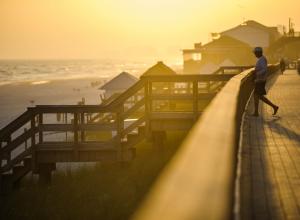Red Tide Reports and Information for South Walton & 30A Florida
Red Tide can ruin a day at the beach in Walton County, Florida. Luckily, Red Tide is pretty rare in South Walton. The 30A beaches rarely get Red Tide, but when it come it is no fun. Red Tide can ruin a vacation if it is present in the Gulf of Mexico. Although sometimes it is mild and people think it is an allergy irritation or a mild cold. Sometimes it is severe and makes you feel like you have the flu.
Red Tide affects people differently. If Red Tide is heavy, you definitely want to stay out of the water. And it may be difficult to be on the beach or even near the beach.
Pretty much every year, usually in summer and fall, there are national media reports about Red Tide, and folks coming to SoWal get concerned even thought the reports are typically about South Florida in the Tampa Bay area.
Visit the SoWal Forum for local reports and current red tide status for South Walton & 30A Florida >
See South Walton 30A Red Tide Updates & Conditions from State of Florida >
More information about Red Tide reports, tracking and Red Tide in Florida >
Get the latest Red Tide Status Report by Phone Call (866) 300-9399 at any time from anywhere in Florida toll-free to hear a recording about red tide conditions throughout the state. Callers outside of Florida can dial (727) 502-4952.
The following information about Red Tide is from the State of Florida.
What is a Florida red tide?
A red tide is a higher-than-normal concentration of a microscopic alga (plant-like organisms). In Florida, the species that causes most red tides is Karenia brevis. This organism produces a toxin that can affect the central nervous system of fish. At high concentrations (called a bloom), the organisms may discolor the water. However, red tides are not always red. They can appear greenish, brownish, and even purple in color. The water can even remain its normal color during a bloom.
Is red tide a new phenomenon?
No, it is not a new phenomenon. Red tides have been documented along Florida's gulf coast since the 1840s and probably occurred much earlier.

Often Red Tide isn't visible in the water, but during heavy episodes the water may appear murky or have a reddish-brown tint.
Can red tides be predicted?
Currently, red tides can’t be predicted, but researchers are investigating the possibility. The effects of a red tide (e.g., dead fish and respiratory irritation in people) depend on the location and concentration of the red tide microorganism at a given time. The effects also depend on wind speed and direction. It is important to realize that many people still enjoy the beaches during red tides. Respiratory irritation and dead fish are not always present.
Do red tides occur anywhere else?
Yes, red tide organisms occur elsewhere. Although the organism that causes Florida's red tide is found almost exclusively in the Gulf of Mexico, blooms have been found off the east coast of Florida, and a bloom was detected off the coast of North Carolina in 1987. Scientists believe the Florida Current and Gulf Stream Current carried K. brevis out of the Gulf of Mexico, around South Florida, and up to the Carolina coast. Other types of microorganisms cause different kinds of red tides (now called harmful algal blooms) in other parts of the world as well.
How is red tide related to respiratory irritation?
People experience respiratory irritation (coughing, sneezing, and tearing) when the red tide organism (K. brevis) is present along a coast and winds blow its toxic aerosol onshore.
CAUTION: People with severe or chronic respiratory conditions (such as emphysema or asthma) are advised to avoid red tide areas. Generally, symptoms are temporary. Once exposure is discontinued, symptoms usually disappear within hours.
Are there any long-term effects of red tide on humans?
Researchers are just beginning to analyze long-term effects of red tide on humans and no conclusive findings have been released. Current, research shows that when a person leaves the red tide area, the symptoms usually go away.
Is it safe to swim during a red tide?
Yes, swimming is safe for most people. However, red tide can cause some people to suffer from skin irritation and burning eyes. Use common sense. If you are particularly susceptible to irritation from plant products, avoid red tide water. If you experience irritation, get out of the water and thoroughly wash. Do not swim among dead fish because they can be associated with harmful bacteria.
Does cooking destroy the red tide toxin?
No, cooking does not destroy the red tide toxin.
Is it okay to eat shellfish during a red tide?
No, shellfish should not be eaten during a red tide. If a shellfish-harvesting ban is in effect, it is not safe to eat mollusks (e.g. clams and oysters). However, edible parts of other animals commonly called shellfish (e.g. crabs, shrimp, and lobsters) are not affected by the red tide organism and can be eaten.
Which shellfish are included in a shellfish-harvesting ban?
Harvesting of bivalve mollusks such as clams, oysters, and coquinas is banned during red tides.
Is it okay to eat fish, crabs, or shrimp during a red tide?
Yes, fish, crabs, and shrimp can be eaten during a red tide because the toxin is not absorbed in the edible tissues of these animals. However, if a red tide is in the area, eating distressed or dead animals is discouraged because the reason for the animal’s strange behavior or death cannot be absolutely known. It could be something unrelated to red tide.
Is it okay to eat scallops during a red tide?
Yes, as long as you only eat the muscle of the scallop. Do not eat whole animals.
How long does red tide usually last?
Red tide ranges from two weeks to 18 months. It depends how long the nutrients that the organism feeds upon exist.
___________________________________________
As part of an ongoing education effort on red tide research, The Florida Fish and Wildlife Research Institute (FWRI) has created an animated video on red tide in Florida’s marine and estuarine waters.
Full Video - What is Red Tide? Is Red Tide Dangerous to Humans? How Do We Track Red Tide?













